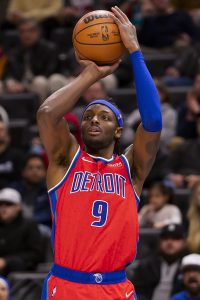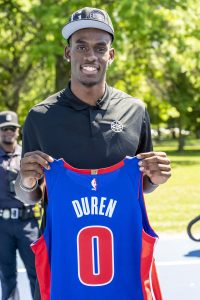This is the second in our series breaking down the major trades of the 2022 offseason. As opposed to giving out grades, this series will explore why the teams were motivated to make the moves. Let’s dive into a pre-draft deal between the Trail Blazers and Pistons…
 One of the most anticipated – and highly-rumored – trades of the offseason came to fruition when the Trail Blazers acquired Jerami Grant from the Pistons in exchange for Milwaukee’s 2025 first-rounder (top-four protected), a second-round pick swap (No. 46 for No. 36, used on draft-and-stash sharpshooter Gabriele Procida), and two future second-rounders (2025 and 2026).
One of the most anticipated – and highly-rumored – trades of the offseason came to fruition when the Trail Blazers acquired Jerami Grant from the Pistons in exchange for Milwaukee’s 2025 first-rounder (top-four protected), a second-round pick swap (No. 46 for No. 36, used on draft-and-stash sharpshooter Gabriele Procida), and two future second-rounders (2025 and 2026).
Portland used its $21MM traded player exception (created by sending CJ McCollum to New Orleans) to accommodate Grant’s $20.96MM salary for 2022/23 without having to send any back. Grant is only under contract through next season, so he’s on an expiring deal.
There were rumors that the Trail Blazers might be willing to include their lottery pick (No. 7 overall, used to select Shaedon Sharpe) in a package for Grant, but that never made sense for a number of different reasons. Grant is a good player, no doubt, but he’s 28 years old, has never been an All-Star and only has one year left on his deal – I’m not trying to imply Grant can’t improve, but one year of team control vs. a mid-lottery pick with four years of control at a friendlier rate isn’t a particularly hard choice, especially since the latter has up to nine years of potential control due to restricted free agency.
So why did Portland deal away a future first-round pick, a second-round pick swap and two future seconds for Grant?
The Trail Blazers have been looking for forwards with good size and versatility to complement star Damian Lillard for several years. They’ve gone through several iterations of forwards since Lillard entered the league in 2012, with perhaps the most successful duo being Al-Farouq Aminu and Maurice Harkless, two defensive-minded players who started when the team made the Western Conference Finals in 2019 (that’s not to say they were the “best,” but the team had the most success that season).
Like McCollum, Lillard is a below-average defensive player. Those limitations on defense made their on-court fit questionable, despite their good relationship and stellar offensive contributions. The Trail Blazers still have question marks at the second guard spot, as Anfernee Simons — who re-signed with the team for $100MM over four years as a restricted free agent — is also a defensive liability.
The club did add Gary Payton II in free agency for backcourt depth, and he’s one of the league’s top perimeter defenders. The Blazers also got Josh Hart in the McCollum trade, another solid defender and good rebounder, though he could start next season at small forward.
Which brings us back to Grant, who has proven to be a player capable of contributing on both ends of the court. He was a high-level “3-and-D” role player for the Thunder and Nuggets before signing a three-year, $60MM contract with Detroit, where he showed he was capable of packing more of an offensive punch.
Across two seasons with the Pistons from 2020-22, Grant averaged 20.9 PPG, 4.4 RPG, 2.6 APG and 1.1 BPG on .428/.353/.842 shooting in 101 games (33 MPG). While his field goal percentage wasn’t the greatest, keep in mind that he was Detroit’s leading scorer during his tenure, and got to the line (6.0 attempts per game) and converted his free throws at a good clip.
Admittedly, the fact that Grant averaged over 20+ PPG the past couple of seasons is less impressive considering the team struggled mightily during that time. He’s also not a great passer, but likely won’t be asked to do that much for Portland.
Having said that, if you actually watched him play for the Pistons, you would have seen that Grant was a three-level scorer who can create his own shot against a variety of defenses and did so with league-average efficiency (55.6% true shooting percentage). That’s no easy task when opposing teams have scouting reports specifically designed to prevent you from scoring.
The last time Lillard played with a 20-point scorer in the frontcourt was from 2012-15 (Lillard’s first three seasons) with LaMarcus Aldridge, but that was short-lived – Aldridge left for San Antonio in free agency in July of 2015. Grant likely won’t average 20+ PPG for Portland, but the fact that he’s talented enough to do so is a nice bonus.
Prior to his offensive emergence with Detroit, Grant was known as a highly versatile defensive player, capable of switching across multiple positions. He’s athletic, slides his feet well, and uses his length to deter shots. He was the Nuggets’ primary wing defender during the team’s run to the Conference Finals in 2020, frequently guarding LeBron James.
Grant is still more than capable of contributing on that end — he just wasn’t as focused on it the past couple of seasons. His primary weakness on the defensive end is that he’s a below-average rebounder, with a career mark of just 3.9 RPG in 26.0 MPG.
It’s also worth noting that Lillard and Grant have experience playing together, winning a gold medal at the Tokyo Olympics last Summer with Team USA. Lillard was effusive in his praise of the move a couple of weeks ago.
“I loved it. That was like the No. 1 thing I wanted to get done,” he said. “Jerami has been on winning teams in OKC and Denver. He brings something to the game that we haven’t had at that position.”
Lillard also recently signed a two-year extension with the Blazers, keeping him with the only franchise he’s ever known for the foreseeable future.
If Grant is such a solid two-way player, why did the Pistons deal him away?
Well, for starters, since Grant is 28 years old and in the midst of his prime, he fits much better on a team trying to make the playoffs again next season like the Blazers than he does with a team full of players on their rookie contracts.
As previously mentioned, Grant only has one year left on his deal, and does it really make sense for the Pistons to pay him when he’s going to be looking for a long-term contract at a higher rate than his current deal? No, not really.
 Would there be benefits of keeping around a good veteran player? Sure. Part of the reason Grant signed with Detroit is because he had a good relationship with GM Troy Weaver during their time together in Oklahoma City, plus he was drawn by a bigger offensive role and the chance to play for an organization led by an African American coach (Dwane Casey) and GM.
Would there be benefits of keeping around a good veteran player? Sure. Part of the reason Grant signed with Detroit is because he had a good relationship with GM Troy Weaver during their time together in Oklahoma City, plus he was drawn by a bigger offensive role and the chance to play for an organization led by an African American coach (Dwane Casey) and GM.
However, having a player who is too good to not start impeding the minutes and development of your young players can be an awkward fit, particularly for a team focused on the future like Detroit. Grant was a desirable player for a number of teams, and he had good value, as evidenced by Detroit’s return package.
The Pistons later flipped the Bucks’ first-rounder in a draft-day deal with the Knicks to land the draft rights to Jalen Duren, the No. 13 pick, and Kemba Walker‘s expiring contract. At 18 years old, Duren is one of the youngest players in the draft class and is considered a rim-running center with a good amount of upside, particularly on defense. Walker is unlikely to play a game for Detroit, as he’s reportedly being bought out in order to become a free agent.
So in the end, the Pistons acquired a late-lottery pick in Duren, upgraded the No. 46 pick to No. 36, got a couple of future second-rounders, and freed up some cap space in exchange for a good player on an expiring deal who wasn’t in the team’s long-term plans. All in all, a very solid piece of business for Weaver.
Dames rookie year was 2012-13, not 2014-15
Good catch, thanks. No idea how I missed that.
Knicks should of went after Grant.
Pistons also traded away a heavily protected future first round pick in the Duren deal. Not sure why most of the media is missing this. Please correct me if I’m wrong
Are you referring to the Pistons’ top-18 protected 2023 first-rounder? Detroit traded that one two years ago and it was flipped to the Knicks in OKC’s trade for No. 11 on draft night. The only first-rounder the Pistons sent out in the Duren trade was the Bucks’ 2025 pick.